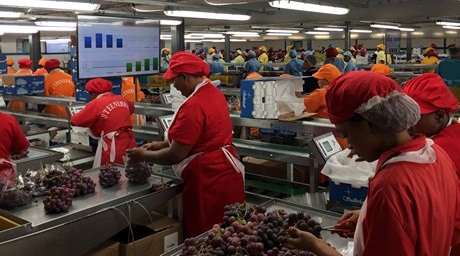The European market presents a challenge to the South African grape industry but one which has just emphasised again the importance of retail programmes, says Clayton Swart, Communications and Market Development Manager at the South African Table Grape Industry (SATI).
The grape season has entered the final weeks – it’s expected to run until the middle to the end of April – with red seedless, the forte of the Hex River. Like the Orange River region before them, some varieties started a week to 10 days later in the Berg and Hex River regions, but according to Swart, Crimson is not one of them.
“Crimson is the bread-and-butter cultivar of the industry, having taken the place of Red Globe previously and which it still has in other Southern Hemisphere grape producers. South Africa, together with the US, stands at the forefront in the presentation of new seedless varieties, in response to market signals.”
Grape intakes are slightly lower than last year this time, but on the export front South Africa is a bit ahead of last year, most grapes going to the traditional market of the EU and the UK, despite low prices.
Impediments to Chinese market focus of SATI’s activities.png?preset=ContentCustom) South Africa faces two hurdles to the Chinese market, which opened to great fanfare and represents a much needed alternative to the traditional markets.
South Africa faces two hurdles to the Chinese market, which opened to great fanfare and represents a much needed alternative to the traditional markets.
The first is a cold steri protocol which, already having been softened two years ago, still is slightly less fruit friendly on some varieties (fortunately not Crimson). The second factor that hampers South African entry to China is the high import tariff of 15%.
“This is a determining factor why the uptake isn’t bigger for the Chinese market. If you’re a producer, you’d probably choose to go to a Euro or Pound market which is an established market for us and where we’re rewarded for quality,” he says. “Then you have a market like China where the moment you enter you’re already more expensive than your competitors which have bilateral agreements with China, which South Africa doesn’t have.”
“Despite all of the impediments, China is definitely still an appealing market. It’s a market that knows grapes and it’s a market that eats grapes. In fact, every year China imports double the total South African harvest, beyond the fact that they are the world’s largest grape producer for domestic consumption.”
SATI is aiming its energy on leveraging the existing relationships between South African companies with interests and partners in China. Together with Fruit SA Chinese importers are invited to South Africa to visit producers and packing facilities, apart from the individual relationships between producers and Chinese grape traders.
“Unlike Europe where, if you’re in the supermarkets, you reach 80 to 90% of consumers, in China it’s the other way around. It’s more wholesale markets and online. It’s a market that you really need to understand and it’s a Dollar market where it’ll cost you dearly if you just charge in without investigating the market structure, for instance in the tier 1,2 and 3 cities and the state of cool facilities which are of cardinal importance to a perishable product like grapes.”
Chinese traders surprised by SA’s leading role in EU and UK
“We’re in conversation with a wide range of role players, to hear from buyers what they’re looking for in our grapes, what they think of our containers, what they think of our product.”
SATI will attend Fruit Logistica Shanghai in May to convey a particular message to Chinese traders. “Our main message, which surprises them somewhat, is that we are market leaders in Europe and the UK and have been for decades. The awareness in China of South Africa as a leading producer of quality table grapes is very low and the little that they know of our country is often not necessarily positive. This we need to change before we can successfully and increasingly sell our product.”

“What distinguishes us from our competitors is that our producers and packhouses are top class. Our food safety, environmental safety and labour practices are among the best in the world.”
The season has been challenging, not only from a marketing viewpoint with many weeks of promotions on grapes in Europe but also from a technical one, as it is believed the drought may have had a residual effect on some vineyards.
"We are, however, still experiencing good packing weather and look forward to a quality finish."
